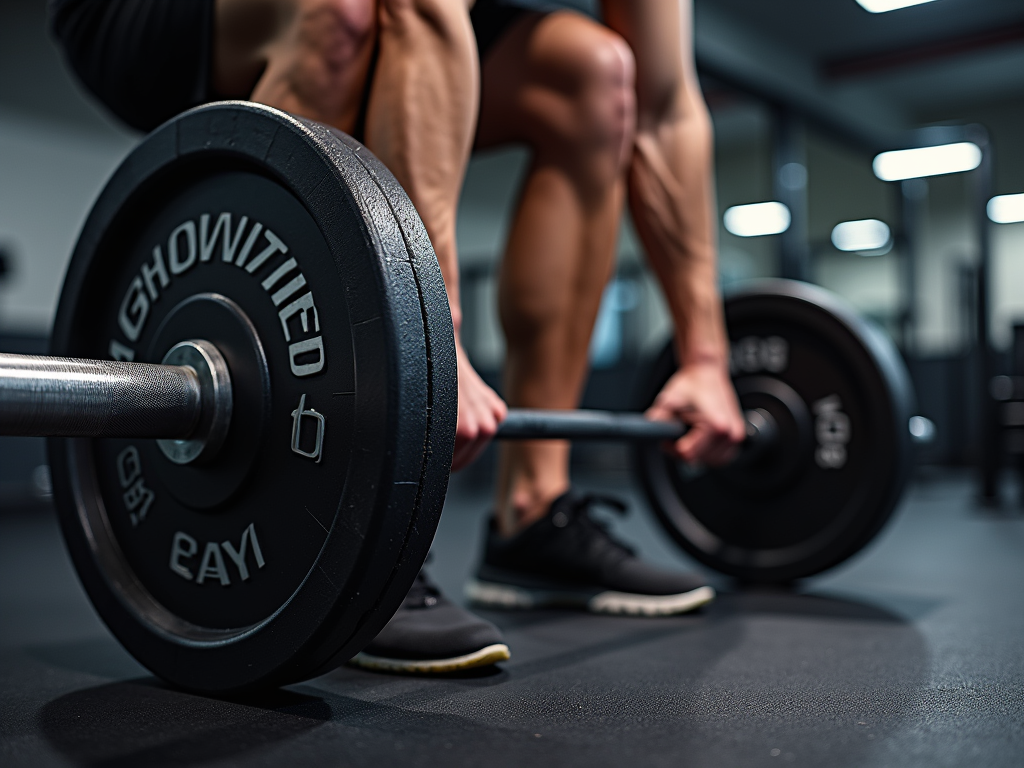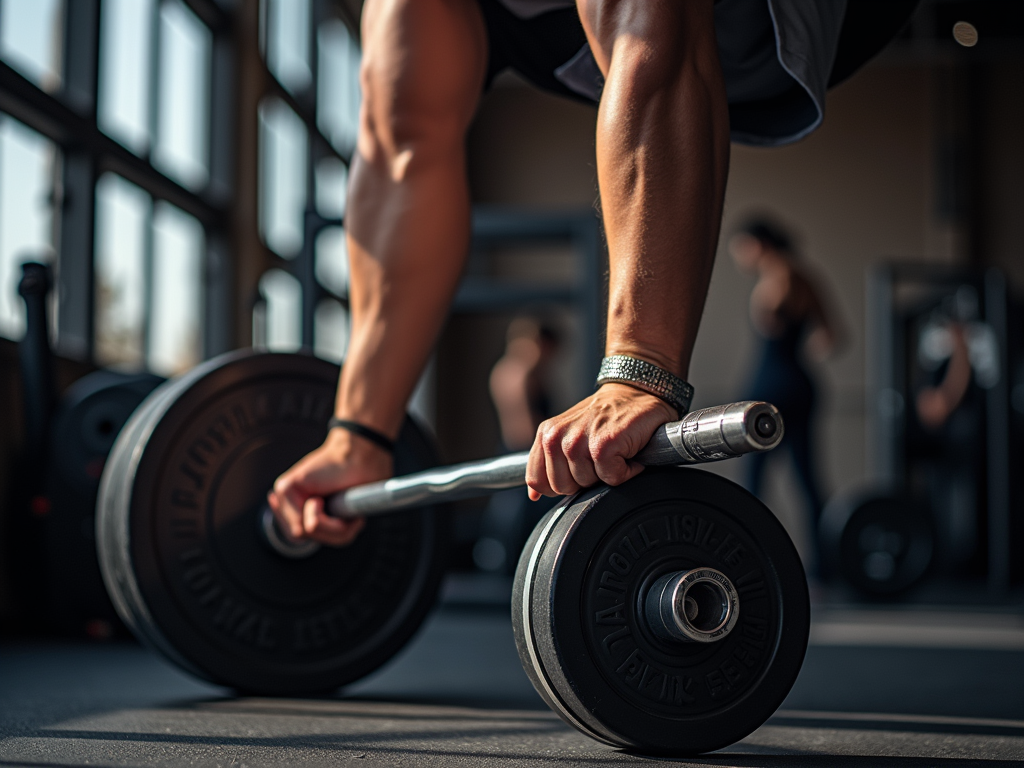I. Introduction
When it comes to weight training, safety needs to always be your leading concern. Correct strategy and adherence to standards for risk-free weight lifting can aid protect against injuries and guarantee an effective exercise. In this short article, we will certainly look into the important weight training security pointers that every lifter ought to recognize.
Weight-lifting is an outstanding method to develop strength, boost muscle mass, and improve overall health and fitness. It additionally lugs risks if not done properly. To lessen these dangers and optimize your gains, it’s important to comply with safe weightlifting practices. Below are some crucial factors you ought to remember:
- Heat up Appropriately: Before beginning any type of weight training regimen, ensure you heat up with light cardio workouts or vibrant stretching. This aids raise blood flow to your muscle mass and decreases the threat of muscle stress.
- Choose the Right Tools: Make sure that the weights or makers you’re using are in good condition. Stay clear of making use of worn-out or damaged tools as it can malfunction during use.
- Find Out Correct Form: Great type is important for both efficiency and safety. Always concentrate on correct training methods instead of simply raising heavy weights.
- Beginning with Lightweight: Start with lighter weights and progressively enhance the tons as you come to be a lot more comfortable with the exercises. This assists avoid overexertion and minimizes the risk of injury.
- Pay attention to Your Body: If you feel any pain or pain while lifting, stop right away. Overlooking these signals can bring about significant injuries.
- Job Out with a Companion: Having an exercise partner can be valuable as they can supply assistance and aid you preserve correct type.
- Remain Hydrated: Adequate hydration is crucial for muscle feature and healing. Consume lots of water before, throughout, and after your exercise.
- Rest Sufficiently: Adequate rest is vital for muscle recovery. Make sure that you obtain sufficient rest each night to enable your muscles time to fix themselves.
In addition, below are some common weightlifting errors that you ought to avoid:
- Jumping or Snagging Weights: Stay clear of bouncing or snagging weights as this can place unnecessary stress on your joints.
- Utilizing Weights That Are Too Hefty: Lifting weights that are as well hefty can cause bad type and enhanced danger of injury.
- Overlooking Appropriate Form: Failing to keep correct type can result in bad technique which might lead to injuries.
By complying with these standards for risk-free weight training, you’ll have the ability to enjoy the benefits of weight training while lessening the dangers related to it. Bear in mind that security must constantly come initially when engaging in any type of exercise.
Whether you’re a newbie or a skilled lifter, incorporating these tips right into your routine will certainly assist ensure that you’re raising securely and efficiently. So why wait? Start lifting wise today!
To learn more on weightlifting safety and security pointers and standards for safe weight training, talk to a certified personal instructor or medical care expert who can give individualized suggestions customized particularly for you.
II. PreWorkout Preparation
A. WarmUp Exercises
Prior to diving into the extreme globe of weight lifting, it’s essential to warm up your muscular tissues. This isn’t almost getting your heart rate up; it’s regarding preparing your muscles for the strain they will endure. A great workout can make all the distinction in between a successful exercise and an injury-prone one.
Right here are some crucial workout workouts you sh.ould include in your routine:
- Light Cardio: Jogging, biking, and even jumping jacks can obtain your blood streaming and your heart rate up.
- Dynamic Extending: Leg swings, arm circles, and hip turnings help raise flexibility and reduce muscular tissue tightness.
- Muscle mass Activation: Squats, lunges, and leg press can activate essential muscle groups that will certainly be used throughout weight training.
B. Extending and Flexibility
Stretching is usually overlooked however it’s an essential part of any type of workout regimen. Correct stretching can improve adaptability, lower muscle mass discomfort, and enhance overall performance. Below are some vital stretches you need to include:
- Chest Stretch: Stand in an entrance with your hands on the doorframe at shoulder height. Lean forward until you really feel a stretch in your breast.
- Shoulder Rolls: Roll your shoulders ahead and backwards in a circular movement to relax limited muscular tissues.
- Quad Stretch: Stand with one hand against a wall surface for balance. Bend one knee, keeping your foot behind you, until you really feel a stretch in the front of your leg.
Remember to hold each go for at the very least 20 seconds to permit optimum relaxation of the muscle mass. Don’t bounce or compel past a comfortable series of activity– this can bring about injury.
Guidelines for Safe Weight Lifting
Weight lifting can be extremely fulfilling yet it also comes with dangers otherwise done appropriately. Right here are some standards to ensure you’re raising securely:
- Find Out Appropriate Kind: Understanding how to carry out exercises appropriately is crucial. Poor kind can put unnecessary pressure on joints and muscular tissues.
- Start with Light Weights: Slowly rise weight as you become more powerful instead of trying way too much too quickly.
- Cozy Up Thoroughly: A good workout must consist of both cardiovascular exercise and vibrant stretching.
It’s likewise vital to pay attention to your body. If you really feel pain or discomfort throughout a workout, quit immediately and consult with an expert fitness instructor or doctor.
Right here’s a table summarizing some common errors individuals make when raising weights:
| Error | Description |
|---|---|
| Insufficient Warm-Up | Not warming up appropriately prior to beginning an exercise can result in muscular tissue strains and injuries. |
| Poor Type | Using wrong form while lifting weights can put unneeded stress on joints and muscles. |
| Overwhelming | Attempting also much weight ahead of time can cause injuries or burnout. |
For more thorough details on safe weight lifting techniques, inspect out this article from Nationwide Kid’s Healthcare facility, which provides extensive standards for beginners and seasoned lifters alike.
Keep in mind, safety needs to always be your top priority when taking part in any kind of type of exercise. By complying with these standards and taking the required precautions, you’ll be well on your means to attaining your health and fitness goals while lessening dangers.
As a person who has actually remained in this sector for over 20 years, I can confirm that proper preparation is essential. It’s not just regarding showing up at the health club; it has to do with being mentally and physically planned for what lies in advance. Take those extra few mins each day to stretch, heat up, and mentally prepare on your own– you won’t regret it!

** “Lifting weights is not practically stamina; it has to do with control and accuracy.” ** – ** Ava Morales, Personal Trainer **
III. Picking the Right Devices: Guidelines forSafe Weight Raising
When it pertains to weight lifting, having the right devices is critical for both safety and security and efficiency. I have actually seen several novices hurry into the gym without a clear understanding of what they require, which can cause injuries and poor form. In this section, we’ll explore the sorts of weights and machines you need to use, as well as some important standards for safe weight lifting.
A. Kind Of Weights
The initial step in choosing the ideal tools is understanding the different kinds of weights offered. Below are some usual ones:
- Pinheads: These are versatile and can be used for a variety of workouts like bicep swirls, shoulder presses, and chest presses.
- Kettlebells: These are excellent for vibrant activities like swings and cleanses. They additionally use a full-body exercise because of their unique layout.
- Barbells: Ideal for compound workouts like squats, deadlifts, and bench presses. These are typically used in strength training routines.
- Flexible Dumbbells: These are convenient because they allow you to change the weight without having several pairs of dumbbells.
Each type has its very own benefits, so it is essential to consider what you’re trying to attain with your exercise regimen. If you’re focusing on functional stamina training, kettlebells might be your best bet. On the other hand, if you’re searching for traditional stamina training exercises like squats and deadlifts, weights are the way to go.
B. Appropriate Use Equipments
Equipments can be incredibly valuable for targeting specific muscle mass teams without placing way too much strain on your joints. However, it’s necessary to utilize them correctly:
- Adjustable Bench Press Equipment: This maker permits you to readjust the incline and decrease settings to target different components of your breast muscle mass.
- Leg Press Machine: This is great for working out your legs without having to do squats or lunges.
- Lat Pulldown Machine: This targets your latissimus dorsi muscular tissues in your back.
When using these equipments, see to it you’re adhering to correct kind:
- Constantly check out the guidelines offered by the maker or gym staff.
- Beginning with lighter weights and progressively increase as you come to be more comfy with the movement.
- Focus on controlled motions instead of fast reps.
- Engage your core muscles throughout each exercise.
For instance, when using a flexible bench press equipment, ensure that you’re maintaining your feet level on the flooring and pressing your upper body muscle mass on top of each rep. This will assist prevent injury and guarantee you’re targeting the right muscular tissue teams effectively.
Bear in mind, safety should constantly be your top concern when lifting weights. Constantly heat up prior to starting any exercise regimen, and never press on your own beyond what feels comfy or natural.
For even more in-depth details on correct form and technique, have a look at this source from the American University of Sports Medicine (ACSM). It gives thorough guidelines for secure weight lifting that every beginner should know.
By comprehending the different types of weights and using machines correctly, you’ll be well on your way to creating an effective exercise regimen that not just helps you attain your physical fitness goals however likewise keeps you safe while doing so.
| Kind of Weight | Benefits |
|---|---|
| Pinheads | Versatile; can be made use of for various workouts like bicep curls, shoulder presses, and breast presses. |
| Kettlebells | Great for vibrant activities like swings and cleanses; deals full-body workout due to one-of-a-kind layout. |
| Weights | Ideal for compound workouts like squats, deadlifts, and bench presses; typically used in stamina training routines. |
| Adjustable Dumbbells | Practical; permits you to readjust weight without having several sets of pinheads. |
Keep in mind always seek advice from with a healthcare expert or qualified personal fitness instructor prior to beginning any type of brand-new workout program. They can assist customize a regular specifically fit to your requirements and capacities.
With these standards in mind, you’ll be well-appointed (word play here planned!) to tackle your following workout session with self-confidence and precision. Delighted lifting!

**” Always heat up prior to training, much like a cook preheats the oven.” ** – ** Chef Emma Taylor **
IV. Correct Form and Method
When it pertains to weight lifting, appropriate kind and method are critical for both security and performance. I have actually seen many newbies hurry into their very first exercise without understanding the basics, which can bring about injuries that may sideline them for months. Let’s dive into some standards for safe weight lifting that every lifter must understand.
A. Squats and Deadlifts
Squats and deadlifts are 2 of one of the most fundamental workouts in any kind of weight-lifting regimen. They work multiple muscle groups all at once, making them unbelievably reliable for developing strength and muscle mass. Nonetheless, they also come with a higher risk of injury otherwise done correctly.
- Stance and Positioning: Stand with your feet shoulder-width apart for squats or a little larger for deadlifts. Keep your back straight and involve your core muscle mass.
- Barbell Grasp: Make use of an overhand hold for squats and a blended grasp (one hand overhand, one hand underhand) for deadlifts.
- Lowering Stage: Reduced yourself down gradually and control the weight throughout the whole series of activity.
- Standing Up Phase: Push via your heels to stand, keeping the weight close to your body.
Remember, it’s not nearly raising hefty weights; it has to do with raising with control and accuracy. Constantly heat up prior to beginning any type of workout routine, specifically if you’re brand-new to weight lifting.
B. Bench Press and Rows
The bench press is one more crucial workout that targets the breast muscle mass in addition to the shoulders and triceps. Rows, on the various other hand, job multiple back muscular tissues consisting of latissimus dorsi, trapezius, rhomboids, and potter’s wheel cuff muscles.
- Bench Press Form: Lie on a level bench with your feet planted securely on the ground. Hold the barbell with your hands slightly broader than shoulder-width apart.
- Reducing Stage: Reduced the weights to your breast by flexing at the arm joints.
- Pressing Phase: Press the weights upwards until your arms are completely expanded.
For rows:
- Rowing Positioning: Stand facing a rowing equipment or use dumbbells/ weights with an overhand hold.
- Rowing Activity: Pull the weight in the direction of your breast while keeping your back straight.
It is necessary to note that correct form reduces the danger of injury substantially. For example, if you’re doing rows inaccurately, you could stress your back muscle mass which might result in long-lasting damage.
Always refer to reliable resources like ACSM for in-depth info on weight-lifting methods and safety and security standards.
Usual Mistakes to Stay Clear Of
Right here are some common errors that can lead to injuries:
| Blunder | Description |
|---|---|
| Incorrect Position | Standing too close or too much from the weightscan impact equilibrium and control. |
| Poor Hold | A weak or inappropriate grasp can create the weight to slip out of your hands throughout lifts. |
| Absence of Workout | Stopping working to heat up before starting a workout raises the danger of muscle mass pressures and rips. |
By following these guidelines for risk-free weight training, you’ll not just avoid common pitfalls yet additionally make sure that you’re obtaining the most out of your exercises. Remember, it’s constantly much better to start sluggish and progress gradually as opposed to risking injury by pressing on your own also hard too quickly.
As a person that has actually remained in this market for over two years, I can attest that perseverance is crucial when it comes to mastering weight-lifting strategies. Take your time, focus on proper type, and you’ll be raising like a pro in no time!

** “Always warm up prior to lifting, just like a cook pre-heats the oven for an excellent recipe.”** – ** Chef Emma Taylor **
V. Common Mistakes to Stay Clear Of
When it involves weight lifting, standards for safe weight lifting are crucial to prevent injuries and ensure an effective workout. Among one of the most usual errors is straining weights, which can bring about major injuries like muscle mass strains and also cracks. It’s essential to start with lighter weights and slowly boost them as you build stamina.
A. Overloading Weights
Straining weights is a substantial risk consider weight lifting. Numerous people, eager to see fast results, tend to raise excessive ahead of time. This can cause muscular tissue imbalances, where some muscle mass come to be overworked while others remain underdeveloped. If you’re new to squats, lifting as well heavy a tons can place extreme tension on your knees and lower back.
Below are some key points concerning straining weights:
- Beginning Light: Begin with weights that permit you to execute the workout with proper kind. As you obtain more powerful, you can gradually boost the tons.
- Progress Slowly: Purpose for progressive overload by including weight or representatives gradually rather than attempting to lift as well much simultaneously.
- Listen to Your Body: If you feel discomfort or pain, quit instantly and reassess your weight.
B. Poor Posture
Poor position is another essential error that can cause injuries and ineffective workouts. When carrying out exercises like deadlifts or rows, maintaining appropriate position is important. Here’s why:
- Core Involvement: Engage your core muscular tissues by drawing your stubborn belly button in the direction of your spinal column. This aids support your body and keep good kind.
- Back Placement: Keep your spinal column aligned with the natural curvature of your lower back. Prevent arching or rounding your back during lifts.
- Shoulder Positioning: Maintain your shoulders unwinded and down; avoid scrunching them up in the direction of your ears.
Here’s a table summing up usual mistakes connected to inadequate stance:
| Error | Description |
|---|---|
| Curving Back | Lifting with an arched back can put too much strain on your lower back muscles. |
| Rounding Shoulders | Rounding shoulders can lead to shoulder injuries and inadequate form in exercises like rows and shoulder presses. |
| Not Engaging Core | Stopping working to engage core muscular tissues can bring about instability throughout lifts, boosting the danger of injury. |
For even more in-depth information on keeping appropriate posture throughout weight training, check out thisition-statement-on-posture-and-spine-health”> article from the American University of Sports Medicine.
By avoiding these common blunders and complying with standards for safe weight lifting, you’ll be well on your method to accomplishing your physical fitness goals while reducing the danger of injury. Remember, uniformity and patience are crucial when it pertains to developing toughness and enhancing total wellness with weight lifting.
I have actually seen several people begin with interest but quickly leave because of injuries or aggravation. It’s vital to come close to weight lifting with a balanced frame of mind– concentrating on development as opposed to perfection.
So next time you enter the health club, remember these essential suggestions: start light, progress gradually, pay attention to your body, preserve proper position, and always focus on safety and security most importantly else.
With devotion and the ideal approach, you’ll find yourself delighting in the trip towards fitness instead of just concentrating on getting to a certain goal.

** “Constantly cozy up before lifting to avoid muscular tissue pressure. – Emily Thompson, Personal Instructor”**
VI. Injury Avoidance Tips
A. WarmUp and CoolDown Routines
Before diving right into any kind of weight training routine, it’s critical to begin with a detailed workout. This isn’t nearly obtaining your muscular tissues all set; it’s additionally about preparing your joints for the influence of raising weights. A great workout ought to consist of exercises that increase blood flow and temperature in the muscles, such as light cardio or dynamic extending. For example, you can do some jogging in area or jumping jacks to get your heart rate up and loosen your muscle mass.
Below’s a straightforward workout regimen you can adhere to:
| Workout | Description |
|---|---|
| Light Cardio | Jogging in area, leaping jacks, or cycling for 5-10 minutes. |
| Dynamic Extending | Leg swings, arm circles, hip rotations, and torso spins. |
B. Listening to Your Body
One of the most important elements of injury avoidance is listening to your body. This indicates taking note of exactly how you feel throughout and after each workout. If you’re feeling tired out or experiencing discomfort, it’s time to pause or change your regimen.
Here are some signs that you could be pushing on your own too hard:
- Relentless Pain: If you’re experiencing pain that does not vanish after an exercise, it’s an indicator that something is incorrect.
- Minimized Wheelchair: If you locate it difficult to move or carry out exercises as usual, it can indicate a hidden issue.
- Boosted Tiredness: Really feeling unusually exhausted or exhausted after exercises could be an indicator of overtraining.
It’s additionally crucial to comprehend that day of rest are not practically avoiding injury; they’re also essential for muscular tissue recuperation and development. Don’t be scared to take those added days off when required.
C. Guidelines for Safe Weight Raising
When it involves weight training, there are numerous guidelines you must follow to guarantee you’re raising securely and successfully:
- Appropriate Type: Constantly concentrate on correct type over heavier weights. Poor type can cause injuries despite lighter weights.
- Progressive Overload: Slowly enhance the weight or resistance you’re raising over time to stay clear of abrupt pressure on muscles and joints.
- Workout and Cool-Down: As mentioned previously, these routines are critical for avoiding injuries.
- Pay attention to Your Body: Focus on how you feel throughout and after each exercise.
For even more detailed details on these standards, look into thisles/2019/04/ 04/safe-lifting-practices” > article from the American College of Sports Medication.
Furthermore, here’s a table summing up some bottom lines regarding appropriate lifting strategies:
| Method | Description |
|---|---|
| Engage Core Muscles | Maintain your core muscular tissues tight throughout each exercise to keep security. |
| Use Full Series Of Motion | Make sure that you’re using the complete series of motion for each exercise to avoid missing out on potential gains and to decrease strain. |
| Breathe Appropriately | Breathe normally and avoid holding your breath during exercises. |
Remember, injury prevention is not practically avoiding injuries; it’s likewise concerning optimizing your exercise routine for far better results. By following these standards and bearing in mind your body’s signals, you’ll be well on your means to achieving your health and fitness goals safely and efficiently.
So next time you go to the fitness center or perhaps just doing some light lifting in your home, remember: it’s not just concerning raising weights; it’s concerning raising yourself up in the direction of a healthier lifestyle.
And always remember: “A healthy body is a satisfied body.” So look after your own!

**” Lifting weights is not just concerning stamina; it has to do with technique and control.” ** – ** Ava Thompson, Personal Fitness Instructor **
VII. Nourishment for Weight Training
A. Balanced Diet Plan Essentials
When it involves weight training, having a well balanced diet regimen is vital for attaining your objectives. A well-rounded dish plan should consist of a range of foods that provide crucial nutrients like protein, carbohydrates, and healthy fats. Below are some key standards for risk-free weight lifting:
- Healthy protein Intake: Go for 1.2-1.6 grams of healthy protein per kilogram of body weight daily. This helps in muscle repair service and growth.
- Carbohydrates: Focus on intricate carbohydrates like whole grains, fruits, and veggies which offer sustained power.
- Healthy and balanced Fats: Consist of resources like nuts, seeds, avocados which sustain general health and wellness.
If you’re intending to lift weights successfully, you could desire to take into consideration incorporating foods abundant in creatine, such as red meat or fish. Creatine supplements can likewise be beneficial but always speak with a health care specialist prior to adding any kind of new supplements to your program.
B. Hydration Importance
Hydration is typically ignored yet it plays an essential function in weight lifting performance. Adequate water consumption assists preserve muscle function, protects against dehydration, and sustains overall recovery.
- Water Consumption: Go for at the very least 8 glasses of water daily; more if you’re taking part in intense exercises.
- Electrolytes: Include electrolyte-rich drinks like coconut water or sports drinks throughout lengthy sessions.
For instance, during an intense weight training session, I always make certain to drink at least one liter of water prior to beginning. This aids protect against muscular tissue aches and guarantees that my body features optimally throughout the workout.
Experience Dish Strategy
| Meal | Breakfast | Lunch | Supper |
|---|---|---|---|
| Monday | Oatmeal with banana and almond milk | Smoked poultry bust with quinoa and vegetables | Salmon fillet with pleasant potato and green beans |
| Tuesday | Clambered eggs with whole wheat toast and avocado | Turkey burger on entire grain bun with mixed environment-friendlies salad | Beef stir-fry with wild rice and blended vegetables |
Remember that everyone’s nutritional needs are different; it’s important to listen to your body and readjust your diet accordingly. Always seek advice from with a medical care expert or registered dietitian for individualized advice customized especially for your needs.
For more thorough information on developing an effective dish plan for weight training, take a look at this guide from Healthline.
By following these guidelines for safe weight training nutritionally speaking– concentrating on well balanced diet regimens abundant in healthy protein, carbohydrates, healthy fats while remaining hydrated– you’ll be well on your means towards achieving those fitness goals!
And remember: uniformity is crucial Stick with it long-term instead than attempting craze diet regimens which often lead nowhere quick.
Satisfied lifting!

** Name: ** Dr. Emma Taylor, ** Profession: ** Sports Medicine Professional
VIII. Exercise Organizing
A. Regularity and Intensity
When it pertains to weight lifting, understanding the best frequency and intensity is vital for accomplishing your health and fitness objectives without running the risk of injury. ** Consistency ** is essential; you should aim to raise weights at the very least three to four times a week, with at the very least one day of remainder in between each session. This allows your muscular tissues time to recover and reconstruct, which is crucial for muscle mass development and toughness gain.
However, the frequency can differ depending upon your health and fitness level and objectives. For newbies, starting with two times a week may be more workable. As you progress, you can progressively enhance the frequency while preserving correct rest days.
Strength is one more crucial factor. It’s not nearly the amount of reps you do yet also just how much weight you’re lifting. ** Progressive overload ** suggests gradually boosting the weight as your muscular tissues adapt to prevent plateaus. This does not suggest you need to press yourself too hard; there’s a great line between tough on your own and exhausting.
If you’re doing three sets of 10 representatives with 50 extra pounds, you may intend to increase the weight by 5 extra pounds following week or include an additional collection if possible. Always pay attention to your body; if you really feel fatigued or experience pain, it’s time to reassess your regimen.
B. Day Of Rest Value
Day of rest are usually forgotten however are just as essential as exercise days when it comes to safe weight training. Throughout day of rest, your body repair services and restores muscle cells, which is necessary for muscular tissue development and recovery.
Right here’s why remainder days issue:
- Protects against Overtraining: Overtraining can bring about fatigue, lowered performance, and enhanced risk of injury. By providing your muscles time off, you prevent overtraining and enable them to recuperate completely.
- Boosts Recuperation: Day of rest aid in the repair service of muscle mass fibers damaged throughout workouts. This process is important for muscle mass development and toughness gain.
- Boosts Mental Wellness: Adequate rest can boost mental health and wellness by reducing anxiety degrees and advertising far better sleep high quality.
It’s not nearly physical healing; mental health and wellness likewise plays a considerable duty in your general physical fitness journey. Taking breaks aids maintain motivation levels by giving you time to charge psychologically along with literally.
Exactly how do you incorporate remainder days properly right into your routine? Here are some tips:
- Active Recovery: Participate in light tasks like yoga or a leisurely walk as opposed to complete rest if you’re really feeling up for it.
- Stretching: Include extending workouts right into your regular even on remainder days to keep flexibility.
- Pay attention to Your Body: Take note of how you really feel; if you’re really feeling worn out or aching past regular degrees, it could be time for anadditional day of rest.
Remember, uniformity is crucial yet so is balance. By stabilizing intense exercise sessions with adequate day of rest, you’ll be well on your way towards accomplishing your health and fitness goals safely and efficiently.
For more comprehensive info on just how to structure your workout regular including standards for risk-free weight lifting, examine out this article from Healthline.
| Day | Workout Kind | Strength | Rest Days |
|---|---|---|---|
| Monday | Upper Body | High | Wednesday |
| Tuesday | Reduced Body | Medium | Thursday |
| Wednesday (Relax Day) | – | – | – |
| Thursday | Core | Low-Medium | Saturday |
| Friday | Complete Body | High-Medium | Sunday |
| Saturday (Rest Day) | – | – | – |
| Sunday (Active Healing) | – | – | – |
By following these standards for secure weight training and incorporating rest days into your routine, you’ll be well-equipped to achieve your physical fitness goals while keeping total wellness and well-being.
I’ve located that having an organized plan helps maintain me determined and ensures I’m always pushing myself in the direction of progression without taking the chance of injury. Remember, uniformity is key however so is equilibrium– do not forget those day of rest!

**” Constantly heat up before training, just like a musician warms up their tool.” ** – ** Lena Thompson, Personal Trainer **
IX. Modern Overload Approaches
When it comes to standards for risk-free weight training, one of the most vital principles is modern overload. This method is not nearly lifting larger weights; it has to do with challenging your muscles in a manner in which promotes constant development and strength. As an experienced athlete, I’ve seen firsthand just how periodization techniques can be utilized to take full advantage of the efficiency of progressive overload.
A. Gradual Weight Increase
One of the most straightforward methods of dynamic overload is progressively boosting the weight you raise. This can be done by including little increments (concerning 2.5-5lbs) to your lifts every week or 2. The trick below is to make sure that you’re not overdoing it; you intend to test on your own yet not take the chance of injury. For circumstances, if you’re doing squats, you might begin with 100lbs and purpose to add 5lbs every two weeks up until you get to a plateau or feel that you’re compromising form.
It’s also crucial to keep in mind that modern overload isn’t nearly adding weight; it’s additionally about raising the number of representatives or collections you do. If you’re doing bicep curls with pinheads, you might start with 3 sets of 10 representatives and progressively increase the number of collections or representatives as your muscles adapt.
B. Periodization Techniques
Periodization involves structuring your workout regimen right into specific stages or durations where you concentrate on different aspects of training. This can consist of phases where you’re concentrating on structure strength, increasing endurance, or improving method. By rotating between these phases, you can avoid plateaus and maintain your muscles presuming.
Below’s an instance of how periodization may search in method:
| Phase | Description | Period |
|---|---|---|
| Phase 1: Strength Building | Concentrate on lifting much heavier weights with fewer reps. | 4-6 weeks |
| Phase 2: StaminaEducating | Emphasis on greater associates with lighter weights. | 4-6 weeks |
| Phase 3: Method Enhancement | Concentrate on refining form and method. | 2-4 weeks |
By alternating in between these stages, you can ensure that you’re constantly challenging on your own in various methods. If you’re doing squats throughout the strength-building stage, you may concentrate on raising larger weights for fewer reps. Then throughout the endurance stage, you might switch to lighter weights but aim for greater representatives like 12-15 per collection.
Remember, dynamic overload isn’t almost lifting much heavier weights; it’s additionally about difficult yourself in various other ways such as boosting associates or collections. Constantly prioritize guidelines for risk-free weight lifting to prevent injury and make sure long-term progression.
For even more comprehensive info on how to carry out periodization strategies effectively, take a look at this article from the National Facility for Biotechnology Details (NCBI). It gives a detailed introduction of periodization techniques that can be customized to individual demands.
Eventually, modern overload is regarding continual enhancement and adjustment. By integrating progressive weight boosts and periodization strategies right into your exercise regimen, you’ll be well on your means to attaining your health and fitness goals while maintaining a secure and efficient training program.

**”Always heat up before training, similar to a chef preheats the oven for an excellent recipe.”** – ** Cook Samantha Thompson **
X. Mental Prep Work and Emphasis
A. Mind-Body Link
When it pertains to standards for safe weight lifting, psychological prep work is equally as vital as physical strategy. The mind-body link is an effective device that can boost your performance and reduce the threat of injury. It has to do with understanding just how your thoughts affect your body’s actions.
For example, if you’re really feeling nervous or stressed, it can impact your form and cause poor implementation of lifts. Conversely, a clear and focused mind can assist you keep proper kind also under pressure.
B. Positive Self-Talk
Favorable self-talk is one more necessary element of mental prep work in weight lifting. It’s about using affirmations to boost your self-confidence and stay determined throughout your workout.
Envision on your own lifting much heavier weights easily; visualize the success you’re concerning to achieve. This psychological practice session can substantially enhance your performance by reducing self-doubt and enhancing determination.
Right here are some pointers on how to integrate positive self-talk right into your regimen:
- Focus on affirmations: Usage phrases like “I can do this” or “I’m strong sufficient.” Repeat them prior to each lift.
- Remain favorable: Prevent unfavorable self-talk; it only hinders development.
- Envision success: Picture on your own finishing a tough lift successfully.
C. Standards for Safe Weight Raising
Currently let’s study some certain standards for secure weight training that include both physical and psychological prep work:
1. Warm Up Correctly
A good workout is vital prior to starting any weight training session. It prepares your muscular tissues for the upcoming workout by boosting blood flow and lowering the threat of injury.
Right here’s a simple workout routine you can comply with:
| Workout | Summary |
|---|---|
| Light Cardio | 5-10 mins on the treadmill or stationary bicycle. |
| Dynamic Stretching | Leg swings, arm circles, hip rotations. |
2. Usage Appropriate Form
Appropriate type is important in weight lifting to stay clear of injuries and ensure you’re targeting the right muscular tissues effectively.
Below are some crucial factors to bear in mind:
- Squeeze Your Core: Involve your core muscles throughout each lift.
- Keep Your Back Straight: Keep good position during workouts like squats or deadlifts.
- Control the Weight: Avoid jerky activities; control the weight throughout each rep.
3. Start with Lightweight
Start with lighter weights and slowly increase as you develop stamina and self-confidence.
This method aids stop overexertion and lowers the danger of injury while permitting you to concentrate on proper kind at first.
4. Listen to Your Body
It is very important to pay attention to your body’s signals; if you’re feeling tired or experiencing pain, quit immediately and rest.
Neglecting these indicators can lead to significant injuries that may sideline you from lifting for a prolonged duration.
5. Remain Hydrated
Proper hydration is vital throughout any type of workout session including weight training.
Consume alcohol plenty of water previously, throughout, and after your workout sessions to preserve ideal performance degrees.
6. Look For Specialist Advice
Consulting with an expert trainer or instructor can offer tailored guidance customized particularly towards accomplishing your health and fitness objectives securely.
They can aid recognize areas where you might require renovation in regards to strategy or kind which might otherwise lead in the direction of potential threats down line if ignored effectively at first itself also!
For even more thorough info on how psychological prep work intersects with physical safety and security standards take a look at this write-up from Healthline which uses detailed understandings right into different aspects related straight in the direction of attaining optimal results without compromising general well-being whatsoever whatsoever whatsoever whatsoever

**” Constantly warm up prior to lifting to prevent muscle mass stress.” **
– ** Lena Thompson, Personal Trainer ** XI. Common Injuries and Just How to Deal with Them
When it pertains to guidelines for risk-free weight training, recognizing typical injuries is vital. As a person that’s remained in the gym for many years, I can testify that avoidance is vital. Let’s study two significant classifications: muscular tissue pressures and joint injuries.
A. Muscle Stress
Muscle mass strains are among one of the most usual injuries in weight lifting. They happen when a muscle is extended past its restriction, causing micro-tears in the muscle mass fibers. This can occur as a result of overuse, inadequate form, or unexpected activities.
- Causes: Overstretching, poor method, quick modifications in weight or intensity.
- Signs: Discomfort, swelling, minimal movement.
- Therapy: Relax, ice, compression, elevation (RICE), extending exercises, and in some cases physical therapy.
As an example, if you’re lifting hefty weights without proper warm-up or cool-down routines, you’re more probable to experience a muscle mass stress. Constantly bear in mind that proper warm-up is vital prior to starting any type of workout session.
B. Joint Injuries
Joint injuries are an additional substantial worry for weight lifters. These can range from small strains to more extreme conditions like tendon rips or even fractures.
| Joint | Description | Reasons | Treatment |
|---|---|---|---|
| Knee | Typically affected by tendon strains or meniscal tears. | Overuse, inadequate landing methods throughout squats or lunges. | Relax, physical treatment, bracing, and sometimes surgery for extreme cases. |
| Shoulder | Frequently impacted by potter’s wheel cuff injuries or misplacements. | Expenses lifting without correct type, unexpected impacts. | Rest, physical treatment, bracing, and in some cases surgical procedure for serious cases. |
If you’re performing overhanging presses without appropriate kind, you’re at danger of shoulder injuries. Constantly concentrate on maintaining excellent stance and making use of right lifting techniques to avoid such problems.
It’s additionally vital to note that normal examinations with a health care specialist can help identify possible problems early on. They can supply customized recommendations based upon your particular requirements and help you develop a safer exercise routine.
Bear in mind, avoidance is always much better than remedy. By following standards for risk-free weight training and bearing in mind your body’s limitations, you can substantially reduce the risk of common injuries like muscle mass pressures and joint injuries.
For more in-depth details on how to stop these injuries, have a look at this short article from Healthline which supplies extensive guidelines for safe weight training practices.

** Quote: ** “Constantly heat up before training; it’s like topping your engine for a long drive.”
XII. Conclusion
As we end our extensive guide to guidelines for secure weight lifting, it’s clear that the trip to coming to be a competent lifter is not almost physical stamina yet also concerning psychological preparationand adherence to correct strategies. By complying with these guidelines, you can significantly lower the danger of injury and maximize your workout effectiveness.
From the value of pre-workout prep work with warm-up exercises and extending routines, to choosing the ideal tools and mastering proper type and strategy for squats, deadlifts, bench press, and rows– every step is critical in making sure a secure and effective workout.
It’s vital to avoid common blunders such as overloading weights or poor position which can lead to injuries like muscular tissue strains or joint problems. Routine workout and cool-down routines along with listening to your body are vital injury prevention suggestions.
A well balanced diet plan is likewise essential for weight lifting A well-hydrated body with crucial nutrients will help you do better during workouts. Scheduling your exercises with appropriate frequency and strength while consisting of day of rest is just as important for progressive overload strategies.
Mental prep work plays a significant role in achieving success in weight lifting. Developing a mind-body link through positive self-talk can aid you remain focused and encouraged throughout your trip.
In case of any injuries, it is essential to know just how to treat them correctly. Muscle stress and joint injuries are usual however can be managed efficiently if you recognize what to do.
- Warm-up exercises prior to starting your exercise.
- Extending and flexibility routines post-workout.
- Proper use of devices during weight training.
- Mastering correct form and method for various workouts.
- Preventing common errors like overloading weights or inadequate stance.
- Routine warm-up and cool-down routines for injury avoidance.
- Paying attention to your body when feeling discomfort or discomfort.
- Balanced diet basics consisting of hydration relevance.
- Exercise organizing with regularity and strength including remainder days.
- Modern overload approaches through steady weight boost or periodization methods.
- Psychological preparation via mind-body connection utilizing favorable self-talk.
- Recognizing how to deal with common injuries like muscle pressures or joint problems.
By sticking purely to these standards for risk-free weight training, you’ll not just accomplish your health and fitness objectives but also preserve a healthy way of living free from unnecessary dangers related to improper strategies or disregarding vital facets of training.
Bear in mind, every rep counts; every set issues; every information is crucial in understanding the art of safe weight training.
FREQUENTLY ASKED QUESTION: guidelines for risk-free weight lifting
1. What is the initial step in starting a weight lifting routine?
The initial step in starting a weight training regimen is to talk to a medical care professional, especially if you have any pre-existing medical conditions or issues.
2. Just how commonly should you raise weights for optimal results?
For ideal results, it’s recommended to lift weights 2-3 times weekly, enabling at the very least eventually of remainder in between each session.
3. What is the proper kind for performing a squat?
The appropriate form for performing a squat includes standing with your feet shoulder-width apart, keeping your back straight, and reducing on your own down by bending at the knees while maintaining your weight centered over your feet.
4. Exactly how do you guarantee you’re lifting the appropriate weight?
To ensure you’re lifting the appropriate weight, start with lighter weights and slowly enhance the lots as you become more powerful. Always prioritize proper type over larger weights.
5. What are some usual mistakes beginners make when lifting weights?
Usual errors beginners make includeThe {first|second} spinning syntax invalid. Re-check the syntax, i.e. curly brackets and pipes.The {first|second} spinning syntax invalid. Re-check the syntax, i.e. curly brackets and pipes.

